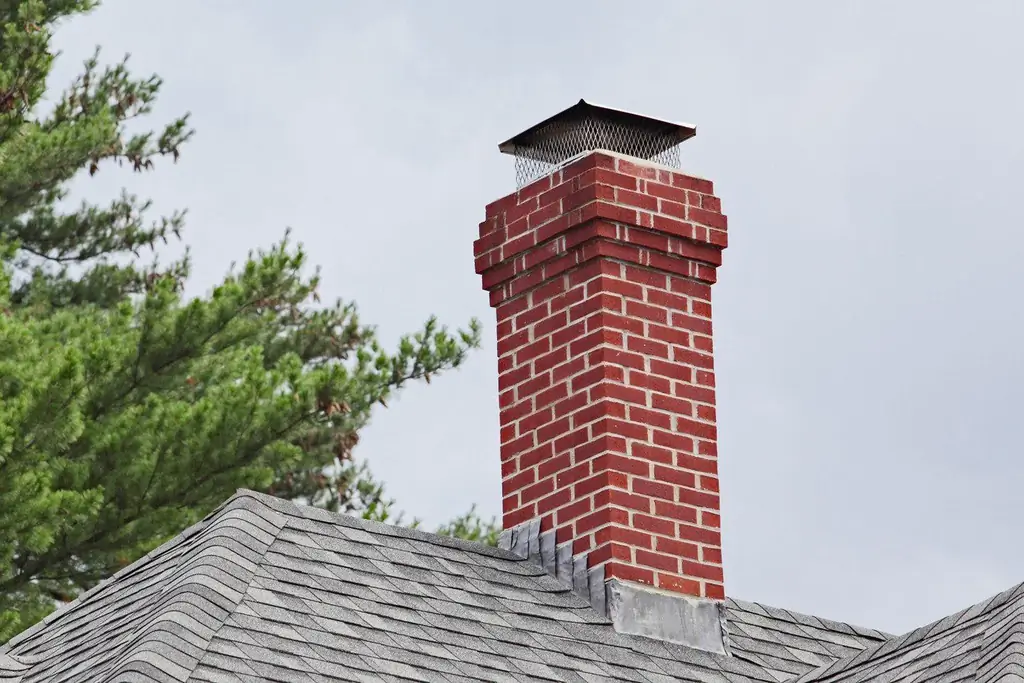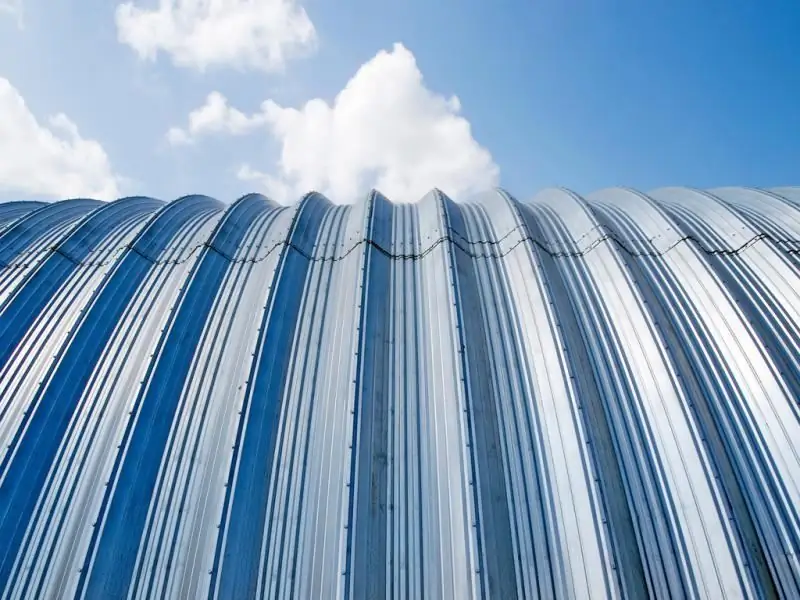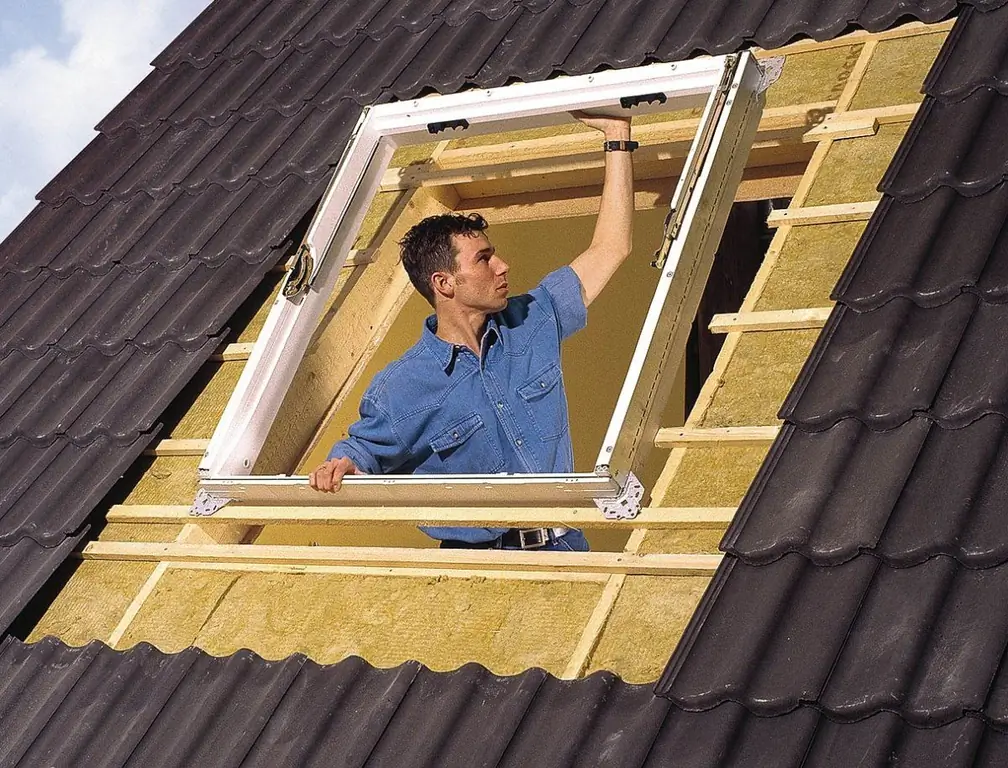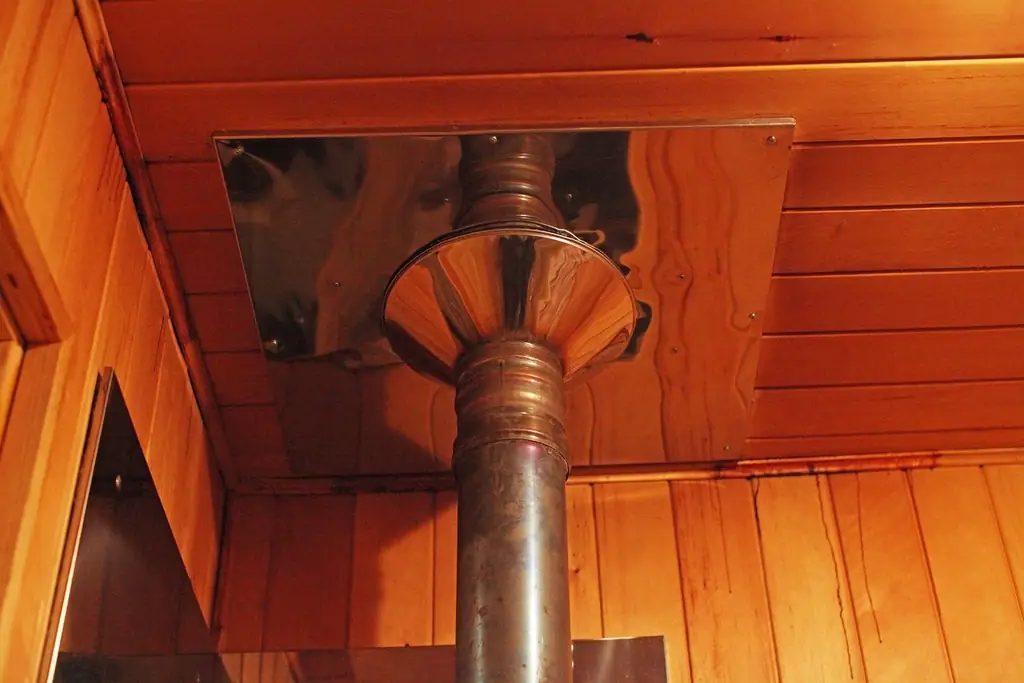
Table of contents:
- Author Bailey Albertson [email protected].
- Public 2023-12-17 12:53.
- Last modified 2025-06-01 07:32.
DIY brick chimney

The chimney of a private house can be made of completely different materials. It can be metal, foam blocks, or bricks. The use of refractory red bricks is still considered traditional.
Content
- 1 Specificity of brick chimneys
- 2 How to choose a brick
-
3 Chimney masonry
- 3.1 Required tools and materials
-
3.2 Step by step guide to making a brick chimney
3.2.1 Video: how easy it is to make a brick chimney
-
4 How to finish a brick pipe on a roof
4.1 Video: installation of the pipe connection
- 5 Rules for the operation of brick chimneys
- 6 Reviews of owners of brick chimneys
The specifics of brick chimneys
Fireplaces, stoves and boilers can be found in modern private houses. To ensure the safe removal of combustion products, a brick chimney is often arranged. This design is used exclusively for single furnaces and boilers.

A red brick chimney is considered the most popular way to organize the removal of combustion products of solid fuel stoves and boilers.
Brick chimneys, regardless of their shape and design, have undoubted advantages, which explains their great popularity:
- Resistant to high temperatures. The bricks used for laying the chimney are able to withstand temperatures of about 1000 o C, while the temperature in the fireplace insert does not exceed 750 o C.
- High level of efficiency. Brick is capable of storing heat.
- Low cost.
- Aesthetics. The brick chimney will harmoniously fit into the exterior of any house, regardless of its style direction.
When selecting material for the construction of a chimney with your own hands, it is worth remembering about the negative qualities. These include:
- Non-optimal shape of the smoke exhaust channel. The presence of corners can slow down the removal of combustion products.
- The presence of roughness on the inner walls, due to which the soot will intensively settle on them, which means that the working space will decrease and the thrust will weaken.
- Great weight. For the construction of a brick chimney, it is imperative to lay the foundation.

A brick chimney consists of several typical elements, the device of each of which is mandatory
The brick chimney is of a typical design. It consists of:
- kiln neck, which is the part of the chimney located between the kiln and the cut. Here is a valve that serves as a means of controlling the draft and fuel combustion;
- fluffing (its other name is cutting), which is located on the passage of the ceilings - a part of the chimney designed to protect the ceiling from high temperatures. That is why the walls of the fluff are made slightly thicker than in other parts of the chimney (the recommended thickness is about 35-40 cm);
- chimney riser, which is located under the roof;
- otter, located on the roof and serving to protect the entire structure from precipitation and condensation;
- the neck of the pipe, which is laid out over the otter and looks like a riser;
- head - a small extension that is located above the neck of the pipe. A cap is mounted on it, blocking the path of debris (in addition, you can install a deflector to increase traction).
How to choose a brick
The choice of brick must be taken with full responsibility, since the efficiency of the chimney device depends on this. Remember that different types of bricks are suitable for each part of the pipe:
-
Red fireclay or ceramic bricks are well fired. This species has smooth edges, a clear rectangular shape. You can also determine it by knocking. You should hear a peculiar metallic sound. It is recommended to use red fireclay bricks for laying all parts of the chimney, while it is better to choose a brand of at least 200.

Red brick It is recommended to lay out any parts of the chimney with red bricks, especially those located closer to the firebox
-
Pink brick. Is slightly underburned. A dull sound is heard when tapped. Suitable for laying those parts of the structure that are less important in functional terms.

Pink brick With pink brick, you can lay out parts of the chimney that are less significant in terms of functionality
-
The dark brown brick is burnt. It can only be used for the base of the pipe.

Brown brick Brown bricks are usually of low quality and can only be used for the base of the pipe
The ideal parameters of a brick are dimensions 25 * 12 * 6.5 cm.
It is also necessary to choose a working solution. It differs depending on the part of the masonry:
- for a part of the pipe above the roof, you can use a cement-sand mixture;
- laying bricks under the roof is possible only with the use of lime mortar with a share of cement.
Chimney masonry
During masonry, it is recommended to be guided by the requirements for the construction of brick chimneys. The safety in the house, the comfort of being in the home, fuel consumption, cleanliness and safety of the air completely depend on this. The chimney must meet the following criteria:
- When manufacturing the chimney, make sure that there are no horizontal sections of the passage for the exhaust gases. If this cannot be avoided, it is recommended to use special channels, the total length of which should not exceed 100 cm.
- For a flat roof, it is recommended to make a chimney that rises 1 m above the slope.
-
For a pitched roof, other standards are used, which depend on the distance of the ridge line from the pipe outlet:
- if it is less than one and a half meters, then the chimney must be made 50 cm higher than the ridge;
- if the distance from the ridge to the chimney is from 1.5 to 3 m, then they should be at the same level;
-
at a distance of more than 3 meters, the edge of the chimney should be located on a line that runs at an angle of 10 o to the horizontal part of the ridge.

Chimney height relative to the ridge In order to obtain good draft, the head must be positioned at a certain height, depending on the distance between the chimney and the ridge.
There are other requirements that cannot be ignored:
- When building a brick chimney, one must be guided by fire safety requirements, which state that walls with flammable materials should be located at a distance of at least 38 cm from the outside of the chimney. Protective thickenings must be made in the ceilings.
- The chimney height must be at least 5 m from the foundation.
- When building a chimney in a residential building, you need to monitor the thickness of its walls. They must be at least 10 cm.
- In no case should you change the area of the inner channel of the chimney. It must be constant throughout its entire length.
- One chimney can only be used for one stove.
- It is possible to install a chimney inside the outer wall only if the wall itself is made of refractory material. Moreover, it must be insulated from the street side.
Required tools and materials
From building materials, only brick, clay and sand are needed. From the tools you will need:
- hammer, including one with a rubber head;
- meter tape;
- water level;
- impeller;
- trowel;
- 2-3 buckets;
- mixer or drill with an appropriate attachment;
- sieve with fine meshes.
A step-by-step guide to making a brick chimney
If you follow clear instructions, you can make a brick chimney without outside help. It is necessary to carry out all the work in a certain sequence:
-
Determination of the shape and parameters of the pipe. The smoke in the chimney moves in a spiral, so it is recommended to make the inner section round. However, in brick pipes this is not possible. Therefore, the masonry is made in a rectangular shape, but at the same time they try to round off the inner corners as much as possible using a special leveling mixture. For this purpose, plaster is not suitable, because due to temperature changes, it can simply crumble. The size of the chimney depends on the size of the house and the type of stove used. For example, for a Russian stove, the pipe should be 26 * 26 cm in size.

Chimney layout When building an internal chimney, it is necessary to observe the minimum distances from its walls to surfaces finished with combustible materials
-
Mixing the solution. Use pure clay and river sand. It is desirable that the clay is mined from a depth of at least one and a half meters:
- all bulk materials must be sieved through a sieve;
- soak them in water and then stir;
- mix with sand in a ratio of one to two;
- mix the resulting mixture with water, adding 4 parts of the liquid, and leave for 12 hours;
-
stir again until a homogeneous consistency is obtained.

Masonry mortar For laying bricks, it is necessary to knead a mortar of clay, sand and water
-
Laying of the lower part of the structure. First you need to equip the overhead pipe. It is built in such a way that brick dressings are clearly observed. It is located above the stove, it has the shape of a rectangle about 4-6 bricks high. It is imperative to leave a smoke well in the design. The pipe should not reach 6 rows of brick overlap.

Brick chimney masonry The overhead pipe is laid according to the ordering scheme, observing the dressing in each row
-
Construction of fluff and chimney barrel. The height of the neck is approximately 5 bricks, while the size of the smoke channel itself is 13 * 26 cm, the outer dimensions are 59 * 45 cm. You can use non-intact bricks. Inside the channel, so-called brick plates must be installed, which serve to maintain the shape of the chimney. Further, the laying goes in accordance with the ordering scheme:
- starting from the third row, the fluff needs to be increased. At this stage, the size of the outer part of the chimney should be 65 * 51 cm;
- further, the dimensions of the rows increase even further and reach 71 * 57 cm. It is recommended to choose bricks with a thickness of 9-10 cm for this structure;
- the fifth row of fluff is laid out already from solid bricks, two of them are stacked side by side;
- then a hole is cut in the floor and roof;
-
then a riser is erected in the attic and brought out. Remember to bandage the brickwork.

Fluff The expansion of the outer surface of the pipe in the place where the overlap passes is done to ensure fire safety, while the dimensions of the inner channel do not change
-
Chimney masonry over the roof. At this stage, the otter settles in. It consists of 9 rows, each subsequent one should increase by a quarter of a brick. Make sure that the inner canal does not narrow or expand. Laying order:
- starting from the 3rd row, the width of the otter should increase due to the extended bricks;
- from the 4th to the 6th row, the side protrusions are lengthened;
- The 8th and 9th row completely complete the chimney structure and form all the chimney protrusions;
- then proceed to the arrangement of the chimney neck, the height of which is from 5 to 8 rows;
- finish the laying by arranging the head in the same way as on the fluff;
- at the end, a weather vane or a cap is mounted.
Video: how easy it is to make a brick chimney
How to finish a brick pipe on a roof
The chimney finish is carried out in order to make the structure more attractive. Before this, it is necessary to perform thermal insulation. For insulation, it is better to purchase materials that are resistant to high temperatures and moisture. They will help to avoid condensation in winter due to temperature differences. For decoration, facing brick and special roofing material are quite suitable.
Particular attention must be paid to the sealing of the junction of the pipe to the roof. The apron can be made from:
- lead or aluminum flexible tape;
- galvanized metal with a polymer coating.
The apron must be mounted around the entire pipe in two layers, while the lower layer must be placed under the roofing material, and the upper one must be mounted on top of it. To close the top layer with an apron, a special waterproofing film and metal profiles are ideal. The edge of the apron should fit into the groove along the perimeter of the pipe, and the joint should be filled with polymer or silicone sealant.

Seams at the exit of the pipe to the outside are insulated with a two-layer apron
Video: installation of an abutment to the pipe
Rules for the operation of brick chimneys
The brick chimney belongs to the capital structures with a long service life. Periodic maintenance is of particular importance for its proper operation. First of all, this concerns the correct introduction of the chimney into operation. After finishing the installation work, it is necessary to dry the masonry at a low temperature, for which it is recommended to heat the stove several times using a small amount of firewood. This will allow all elements of the chimney to dry out evenly.
During further operation, you need:
- Observe the condition of the foundation, as it can begin to collapse and cause the chimney to skew. If cracks are found, it is necessary to restore it using a concrete-cement mixture.
- Inspect the chimney at least once a year.
- Observe the condition of the head, as it is simultaneously affected by the high temperature of the flue gases and the low temperature of the ambient air. If the head is deformed or destroyed, then precipitation and debris will fall into the chimney and gradually destroy its structure.
- Clean the flue duct. The frequency of cleaning depends on how often the chimney is used. If it works only for one season a year, then cleaning can be done once every three years, and if the stove is heated more often, then it needs to be cleaned once a year.
If a brick chimney is operated according to all the rules and is cleaned on time, it can last up to half a century without repair.
Reviews of the owners of brick chimneys
Remember, nothing is doable. Despite the fact that some people consider a brick chimney to be an outdated design, it is quite possible to combine such an installation with the newest models. Thanks to this, you can give the exterior of your home a certain identity and originality.
Recommended:
The Roof For The Hangar, How To Do It Right, Including With Your Own Hands, As Well As The Features Of Its Design And Installation

How the hangar roof shape depends on its function. The better to insulate the hangar roof. DIY hangar roof assembly instructions
Installation Of Roof Windows, Including With Your Own Hands, As Well As Installation Features In An Already Finished Roof

Step by step instructions for installing a roof window. Features of technology and nuances of installation in various types of roofing
Chimneys For A Bath, Including How To Choose, As Well As Features Of Installation And Operation

Which chimney is better to install on a gas boiler in a bath. Types, features of installation and operation of chimneys. How to check and adjust the draft in the chimney
Chimneys From An Asbestos-cement Pipe, Including How To Choose, As Well As Features Of Installation And Operation

Is it possible to use asbestos-cement pipes for the chimney. When and why they are more appropriate than metal and ceramics. Is the truth about the dangers of asbestos and how to avoid it
Chimneys Made Of Stainless Steel, Including How To Choose, As Well As Features Of Installation And Operation

What are stainless steel chimneys, how to choose them correctly. Installation of internal and wall chimneys. Features of operation and owner reviews
